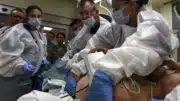Overview:
Lawmakers earmarked millions to beef up North Carolina’s rural health infrastructure in the recent budget in hopes of improving outcomes.
By Jaymie Baxley and Rose Hoban
In recent years, lawmakers in Raleigh have fretted about how to increase access to health care for North Carolina’s 3.5 million rural residents.
They have traveled the state, holding hearings for residents and health care providers outside the urban and suburban regions. Providers from those areas have traveled to Raleigh, too, to testify at legislative hearings about staffing shortages and other critical issues plaguing their practices.
Some dollars have flowed to smaller burgs, but those financial infusions never matched the requests for funds to significantly alter the health care access landscape.
That calculus changed last month when lawmakers adopted a nearly $30 billion spending plan for the next two years that makes a significant investment in health care. The General Assembly made a noteworthy commitment to bolster rural health and get more providers working in the state’s 80 rural counties.
Aside from more than $400 million designated to UNC Health and ECU Health for initiatives that include the establishment of three new rural clinics, the legislature put tens of millions of dollars towards enticing health care providers to work in North Carolina’s rural areas. They also allotted funds to beef up rural telehealth infrastructure.
Much of that money comes from a one-time payout of about $1.6 billion in federal funds flowing to the state thanks to financial incentives tied to the state’s adoption of Medicaid expansion.
Lawmakers designated much of that money for rural initiatives, with hopes of improving flagging health outcomes in those parts of the state.
New option for rural hospitals
Twelve rural hospitals in North Carolina have either shut down or stopped providing inpatient care since 2005, according to data from the Cecil G. Sheps Center for Health Services Research. The only states that saw more closures over the same 18-year period were Texas and Tennessee.
Mark Holmes, director of the center, said the budget language extends a potential lifeline to at-risk institutions through a relatively new federal program designed to keep rural hospitals afloat.
Established by Congress as part of the Consolidated Appropriations Act of 2021, the program allows struggling hospitals to convert into so-called “rural emergency hospitals” — a designation that can bring them more than $3 million in annual funding from the Centers for Medicare and Medicaid Services. The budget includes “enabling language” for hospitals that wish to make the switch, according to Holmes.
“Prior to that language, if a hospital in North Carolina wanted to convert to [a rural emergency hospital], they’d be out of luck because the state had no recognition of what this provider is,” he said. “It was an important step to ensure that rural communities have as many options as possible to meet the needs of the residents.”
The catch? Rural emergency hospitals are required to discharge or transfer their patients to a larger facility within 24 hours, something that may make some rural hospital leaders balk.
But it’s a model that’s worked for the small Anson Health Atrium facility. What used to be a full-service hospital in a rural county transformed to become primarily a multi-specialty clinic that feeds patients to the larger Atrium system in nearby Charlotte.
During a recent presentation in Rockingham County, Holmes said that North Carolina’s rural hospitals are less reliant on inpatient services than their urban counterparts. Outpatient services, he said, make up about two-thirds of rural hospitals’ business.
“While offering a less complete set of services than a hospital, it’s more than what other options might be there, which include a complete closure,” Holmes said of the rural emergency designation in a phone interview. “I’m glad the General Assembly undertook that and made sure that there’s a provision for state licensure.”
On top of that, lawmakers earmarked $12.5 million in “stabilization” dollars that can be used to provide loans to hospitals in rural areas of the state that are in “financial crisis.”
Getting providers and keeping them there
The budget attempts to offer incentives to draw more health care workers to North Carolina’s rural areas.
One line item allocates $50 million over the next two years to bolster a state program that repays educational loans for mental health professionals who commit to working at least three years in a rural or underserved community. It’s an investment that Holmes believes could help rural providers recruit — and retain — qualified personnel.
Five million of those dollars each year will go to loan repayment and recruitment and retention incentives for general surgeons, internists, pediatricians, OB-GYNs and psychiatrists. The budget specifies that $2 million of that money annually must go to family physicians, pediatricians or psychiatrists, the types of providers who provide the backbone of health care.
“We know that these kinds of programs are highly effective in identifying not just physicians but all kinds of health workforce, and we know that there are often shortages in rural areas,” Holmes said. “That will have a direct and immediate impact in the expansion of options available to employers in rural and underserved areas to boost the number of providers who are interested in working in those communities.”
The spending plan also includes provisions to expand the pool of practitioners through training. The University of North Carolina system, for example, will receive a special appropriation of more than $15 million over two years to establish a residency program focused on rural communities. This will be on top of an existing rural residency program in western North Carolina at the Mountain Area Health Education Center.
“While recruitment and retention incentives are useful in encouraging providers to locate in places where we want more of them, we also know that training providers of all types in rural areas is highly effective in getting them to not just stay in the community but other rural and underserved locations throughout the state,” Holmes said.
An alliance of giants
Arguably the most ambitious rural health initiative in the budget, NC Care is a $420 million collaboration between UNC Health and East Carolina University.
The systems will work together to establish “outcome driven regional systems of care, beginning in eastern North Carolina,” according to the budget. Half of the funding for the project, about $210 million, will be used to establish three health clinics in rural areas.
The plan sets aside $150 million for “hospital investment.” About $50 million will go toward the development of a regional children’s hospital at an undetermined site in the Triangle.
Holmes said NC Care represents a “promising” partnership between the two systems, both of which have a “huge footprint” in the largely rural eastern region of the state.
“I think there’s some real opportunities for synergy and sort of breaking the mold by combining the two systems and thinking about how they can work together to develop new models more efficiently and at a higher quality,” he said.
The collaboration, he added, “sets an example that other states can look at.”
“We’re waiting to see what sort of what develops out of it, but, but the fact they’re willing and excited to sit down together with the support of the state to look at new models really is another example of the tradition that the state has in innovation in rural health delivery.”
Duke University Law School’s Barak Richman, who researches health care financing, is more sanguine about the prospects of the UNC Health/ECU Health initiative. He argues that designating large hospital systems to provide this primary care is likely the most expensive way to provide rural health care.
“If the hospital owns it, it’ll be a hospital facility and there’ll be a hospital facility charge on top of [any fees],” Richman said. “Hospitals have the financial imperative to keep their beds filled, and if a hospital owns the clinic, then come hell or high water, there’s no way to escape the reality that the clinic will be a conduit for hospital referrals.”
Sign up for our Newsletter
“*” indicates required fields
Richman contended that lawmakers could have benefitted from expertise that he and other health economists, such as Holmes, could have brought to the table and come up with a more efficient fix for the woes of rural providers. He bemoaned the process followed by the legislature, where policy was negotiated behind closed doors with little opportunity for public input.
“You can’t, you can’t pretend to have the best ideas if you’re not exposed to different ideas,” he concluded.
The budget dollars include:
- Community health grants – up to $150,000 a year to recipients such as community health centers and rural health centers
- Community health grant program administration – $200,000 per fiscal year;
- Expansion of loan repayment program/incentives for providers in outpatient primary care settings – $25 million on top of the original $7.6 million budget. These dollars are earmarked for:
- Expand the existing loan repayment program – $9 million a year;
- Doctors’ initiative – $5 million a year for recruitment and retention of primary care physicians (family medicine, general internists, general s, general pediatrics, OB-GYNs or psychiatrists), $2 million of that targeting family medicine, general pediatrics or psychiatrists;
- $10 million a year for behavioral health specialist recruitment and retention – can target any one of six types of licensed practitioners, including licensed clinical addiction specialists, licensed clinical social workers, licensed psychologists
- $1 million per annum for expanding the NC Loan Repayment Program to recruit registered nurses and clinical nurse specialists providing primary care services in rural and medically underserved areas.
- Takes $5 million from federal American Rescue Plan Act funds and uses it to fund the state share of dollars earmarked to update the Medicaid reimbursement structure for community health centers and rural health centers. “The new reimbursement structure will relieve administrative burdens and improve cash flow” at these facilities, reads the budget language.
- $2.5 million to the Rural Healthcare Initiative “to create effective models of sustainable healthcare for North Carolina rural communities.”
- Medical assistant apprenticeship pilot program – $1.7 million per year targeted for 50 job placements at existing sites with the:
- $5 million in the first year and $15 million in the second year for telehealth grants to help independent primary care/OB-GYN providers purchase equipment and other infrastructure to conduct telehealth visits. The maximum amount to each grantee will be $250,000.















